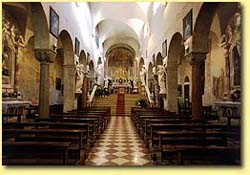
Inside there is a nave and two aisles supported by six equal pillars and four columns of varying ages and styles.
VILLANOVA ABBEY
Information leaflet
Piazza
san Benedetto, 1 - 37047 San Bonifacio (VR) - Tel. and fax:
++39.045.7610253
www.abbaziavillanova.org
E-mail: abbazia@netbusiness.it
Villanova
di San Bonifacio is situated 25km from Verona and 30km from Vicenza, along state
road no.11 (the ancient consolar roman road “Postumia”), in the province of
Verona and the diocese of Vicenza. It is famous for its ancient Benedictine
abbey dedicated to St. Peter and would appear to have been founded in 763 a.d.
by St. Anselmo of Friuli.
In 1117 a violent earthquake damaged the church and belltower which were rebuilt
by the Abbot Uberto of the Counts of San Bonifacio, in romanic style, between
1131 and 1138. Later, from 1390 to 1410, the Abbot Guglielmo of Modena restored
the building in gothic style and built the belltower cell. The Olivetan monks (who
served in
the abbey from 1562 to 1771) made remarkable modifications in baroque style. In
1771 the Veneto Senate suppressed the monastry of St. Peter in Villanova so that,
after 1008 years of monastic life (excepting just over a century from 1450 to
1562 in which monks were absent) it was included among the parish churches of
the diocese of Vicenza.
On 23rd April 1949, with a concistorial decree, Pope Pio XII restored the
title of “abbey” to St. Peter of Villanova.
THE STYLES
In
the church three different styles can be observed:
–
Romanic
(Abbot
Uberto of San Bonifacio): a) general structure of the church;
b)
lower part of the belltower.
–
Gothic
(Abbot
Guglielmo of Modena):a) rose-window of the facade;
b)
belltower cell with windows with three lights, spire and pinnacles.
-
Baroque
(Olivetan
monks): a) overstructure of the facade; b) angels of the central nave; c) gable
vaults of the present ceiling
which covers the original wood truss one; d) large
staircase leading to the presbytery
 |
Inside there is a nave and two aisles supported by six equal pillars and four columns of varying ages and styles.
|
The Pleban Church
|
Wall of the right aisle: – “Scenes from the life of St. Benedict” (frescos of the school of Giotto attributed to Martino and Jacopo of Verona; second half of the XIV century). –
Baroque
alter decorated with “The Martyrdom of St. Agatha” (painting
attributed to Antonio Balestra of the XIV century). –
“St.
Catherine of Alessandria and St. Agostino” (fresco by unknown artist of
the XIV century. –
“St.
Francesca Romana” (copy of a painting by Guercono of the XVII century). Wall
of the left aisle: –
“The
beatified Bernardo Tolomei” (painting by unknown artist of the XVII
century). –
Baroque
alter with “Pietà” statue in painted stone (a magnificent sculpture
attributed to Egidio di Wienerneustadt of the XV century). –
“Six
figures of Saints” (fresco by
nknown artist of the XIV century).
|
 |
Wall
on the right
–
“Painting of St. Michael the Archangel” (painting by unknown Venetian
artist with eastern influences, of the XV century).
Wall
of the central apse
–
“St. Benedict in glory” (fresco by unknown artist of the XVIII
century).
Lowered
arch to the right:
emblem of the Counts of San Bonifacio.
Lowered
arch to the left:
–
Emblem
of the Counts of San Bonifacio.
Left
wall:
–
Door of the XVIII century, painted with the Olivetan emblem and
privileges of the abbot.
The Crypt
 |
The
beautiful crypt, supported by 24 columns, served as a winter church for the
monks. Left
wall:
“The trial and martyrdom of St. Agatha” (frescos by unknown artist
of the XIV century). Left
Apse:
–
“Christ in almond between two saints”
(fresco by unknown artist of the XIV centurry). –
“Byzantine
Pluteus” (magnificent sculpture by unknown artist of the VIII century). Central
Apse:
–
To the east: small alter made up of a burial stone and elements found
underground. –
To the west: tomb of the venerable don Giuseppe Ambrosini, whose
beatification is under way. Right
Apse:
“Triptych of the Annunciation” (sculpture by unknown artist of the XV
century).
|
Further
works and curiosITIES
–
Three
tomb stones found during the renewal of the abbey floor in 1963.
|
Of
the ancient cloisters can be admired some columns and arches in gothic style,
underpinned during the baroque age along the north and west sides. These
structures are not recognizable along the east and south sides. The four walls
enclose a small garden.
|
|
Several
rooms remain, which have undergone the inevitable modifications attributable to
the hand of both time and man. At present the monastry is undergoing restoration.
The
monastic courtyard
The
large internal space of the “curtis monastica” is still perfectly
recognizable. This is enclosed by walls and old buildings (“barchesse”)
which in part are derelict and now belong to private owners.
How
to reach the abbey
The
Abbey of Villanova is 25km from Verona and 30km from Vicenza, along the state
road no. 11. For those arriving by motorway, leave the Serenissima Motorway at
the Soave-San Bonifacio exit and turn left towards Vicenza. The Abbey is just
1km away. By train, descend at the station of San Bonifacio on the Milan-Venice
line. The Abbey is 15 minutes walk away.